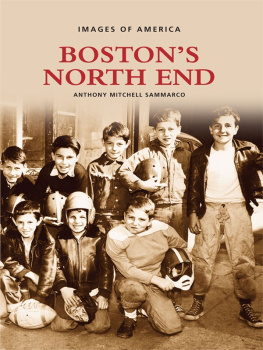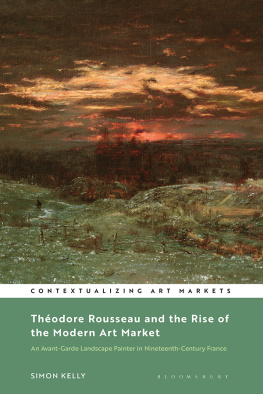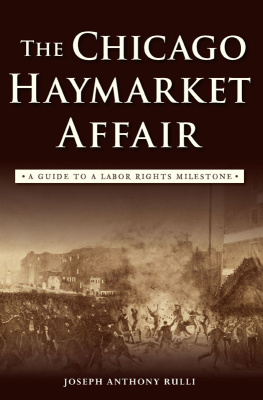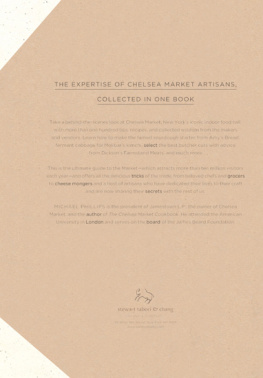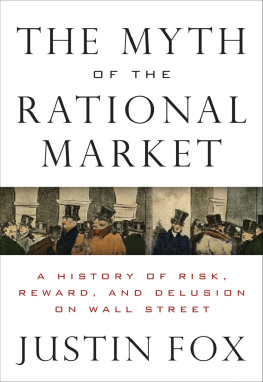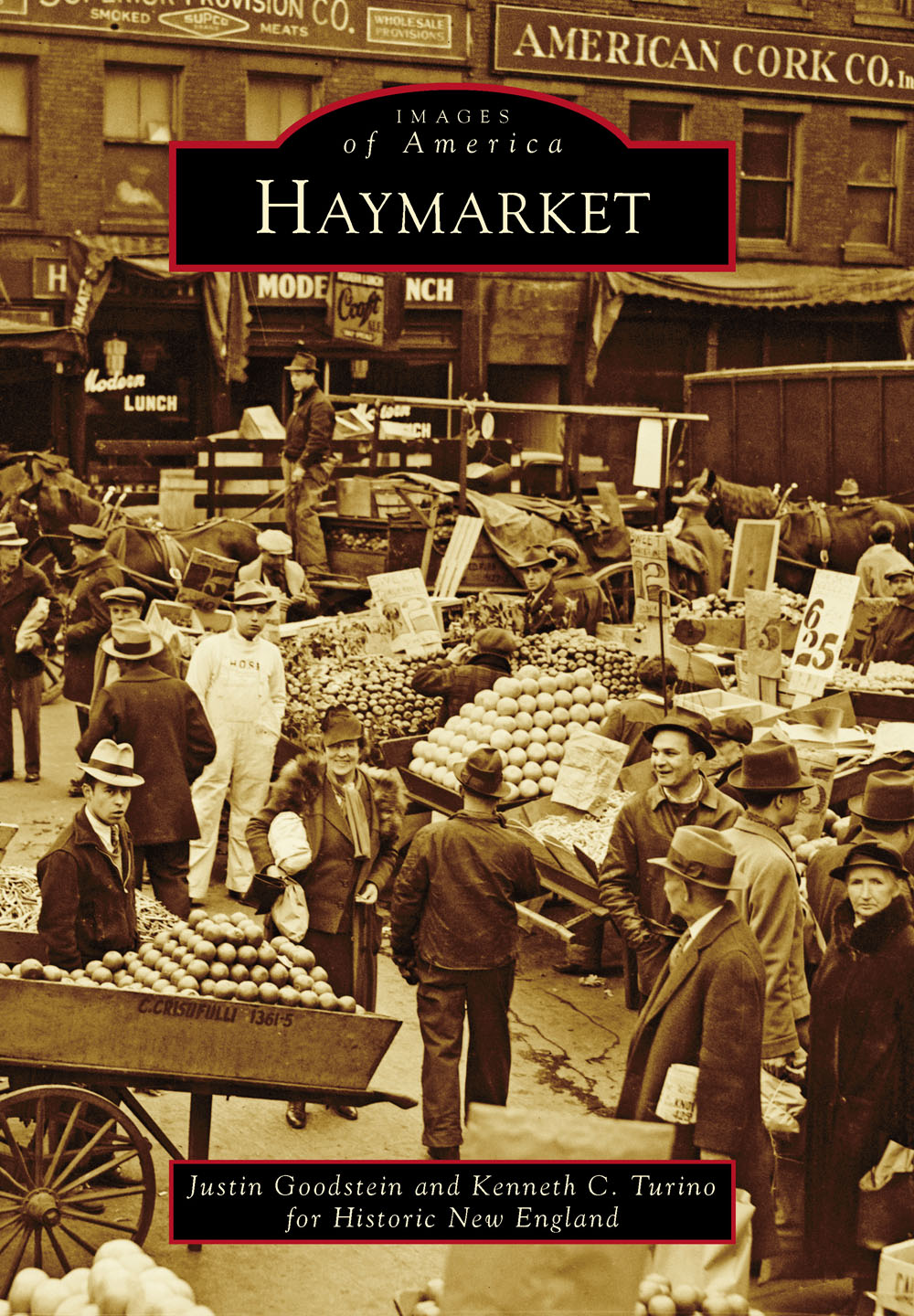
IMAGES
of America
HAYMARKET

William Sumner Appleton, the founder of the Society for the Preservation of New England Antiquities, now Historic New England, collected this image of Baldwin and Georges produce shop at 114 South Market Street. J.W. Baldwin and I.M. George were in business from 1882 to 1887. This peaceful scene shows nothing of the action when the streets were generally crowded with horse-drawn wagons and pushcarts selling and delivering goods along with stacks of barrels and crates and uncollected trash. (Courtesy of Historic New England.)
ON THE COVER: Leslie Jones captured this busy market scene on Blackstone Street in 1940 of young pushcart vendors and customers buying and selling produce. Also pictured are the store fronts, which were a blend of practical merchandise, meat sellers, places to eat, and bars. (Courtesy of the Trustees of the Boston Public Library, Leslie Jones Collection.)
IMAGES
of America
HAYMARKET
Justin Goodstein and Kenneth C. Turino
for Historic New England

Copyright 2015 by Historic New England
ISBN 978-1-4671-3403-3
Ebook ISBN 9781439653555
Published by Arcadia Publishing
Charleston, South Carolina
Library of Congress Control Number: 2015903567
For all general information, please contact Arcadia Publishing:
Telephone 843-853-2070
Fax 843-853-0044
E-mail
For customer service and orders:
Toll-Free 1-888-313-2665
Visit us on the Internet at www.arcadiapublishing.com
This book is dedicated to all the past and present Haymarket workers and the people of Boston whom they have served.
CONTENTS
ACKNOWLEDGMENTS
The authors would like to thank the Haymarket Pushcart Association and the shop owners along Blackstone Street for their support of this project and friendship. In particular, we want to acknowledge Octavio Otto Gallotto, president of the association, and Emanuel Gus Serra, the first president of the association, who today acts as an advisor and intermediary with the City of Boston on behalf of the association.
We would also like to thank Boston area photographers for supporting this endeavor with the loan of extraordinary images, particularly Lou Jones, Wendy Snyder MacNeil, and Peter Vanderwarker. The authors are grateful to Caitrin Cunningham of Arcadia Publishing for providing us with an opportunity to publish the first history of Haymarket.
The authors would like to thank the staff at Historic New England, particularly president and CEO Carl R. Nold and Diane Viera, executive vice president and COO, for embracing the Haymarket Project as part of Historic New Englands Everyones History initiative. This book would not have been possible without the assistance of the staff of the library and archives: Lorna Condon, Jeanne Gamble, and Abby Cramer. Kris Bierfelt, Susan Jarvis, and Sarah Jaworski, who helped research and obtain photographic images and rights, also deserve mention.
The staff of many libraries researched and helped us acquire images, particularly Elizabeth Clemens, Walter P. Reuther Library, Wayne State University; Marta Crilly, City of Boston Archives; Chris Donnelly, Rotch Visual Collections, Massachusetts Institute of Technology; Anna Jedrzejowski, Ryerson Image Centre, Ryerson University; and Aaron Schmidt, Boston Public Library.
Justin would like to thank his wife, Marina, for her encouragement, good company, patience, love, and support of his projects. He also is grateful to Danny Baxter for his unwavering support, advice, and help on each endeavor, no matter how complex. Special thanks go to his mother, Ingrid Marie Aue, who gave him the strength, support, and will to go onteaching him to always give his best. Bernie and David Goodstein, this work is dedicated to you.
Ken would like to thank Chris Mathias for his continued help and most of all his patience. Thanks also go to Anthony Sammarco for his encouragement and help with this project.
INTRODUCTION
This publication on Haymarket, Bostons open-air produce market, grew out of Historic New Englands Everyones History Project, an ongoing exploration of life in New England. Historic New England partnered with the Haymarket Pushcart Association to document Haymarkets vendors, workers, and customers through Justin H. Goodsteins black-and-white photographs and oral history interviews conducted by Kenneth C. Turino. The project resulted in a series of online films, which evolved into a traveling photographic exhibition, Haymarket, The Soul of the City, and a documentary film of the same title, which premiered in July 2015.
Although much has been written about Bostons early markets, surprisingly little has been written about Haymarket. Up until the first half of the 20th century, the area that now encompasses Haymarket was typically referred to as the market district. It included Faneuil Hall and Faneuil Hall Market, popularly known as Quincy Market, and the streets and squares adjacent to them. The name Haymarket derives from Haymarket Square, it having been the location of one of several public scales used for weighing hay for sale. Haymarket Square was at one end of the market district, which ran from Faneuil Hall and Faneuil Hall Market along Blackstone Street.
Bostons earliest settlers were served by peddlers with carts going about the town selling produce and meat. Bostons first outdoor produce and meat market was established around the town dock, the chief place for trading and storing goods. It was near the present site of the Sam Adams statue on the west side of Faneuil Hall. An open-air fish market was located north of the town dock. In 1734, the town voted to establish three markets: one at Dock Square, one in North Square in the North End, and one at South Market on Boylston Street near the present-day intersection of Boylston and Washington Streets. Owing to citizen discontent with an organized and regulated market system, these three markets lasted only three years.
Merchant Peter Faneuil offered at his own expense to Erect and Build a noble structure or Edifice, to be Improved for a Market, for the Use, Benefit, and Advantage of the Town. Faneuil Hall was completed in 1742, but vendors were slow to rent space in this market, and it was forced to close several times. Residents of the town preferred the pushcarts that roamed the city. The original structure was all but destroyed in a fire on January 31, 1761. The town soon after voted to rebuild the structure, and it reopened on March 14, 1763. This time, the market was a success. Residents of the growing city now appreciated the convenience and benefits of a centralized market with regular hours. Faneuil Hall Market followed in 1826. Conceived by Mayor Josiah Quincy, the marketplaces purpose was to relieve the crowded and unsanitary conditions in the market district. Over the course of three years, Quincy worked closely with the city council and the market committee to raise funds to purchase land and build the market. The work included acquiring buildings and wharves and filling in part of the harbor. The plan for the new marketplace also called for the construction of two long buildings (North and South Markets) for use as merchant stores. The initial plan for the market was developed by architect Asher Benjamin but drastically altered and enlarged when Alexander Parris became the chief designer. With the development of Faneuil Hall Market, Bostons market district came into its own. The area around Dock Square, Adams Square, North and Clinton Streets, and Atlantic Avenue became the center of the citys expanding food-merchandising industry.
Next page

